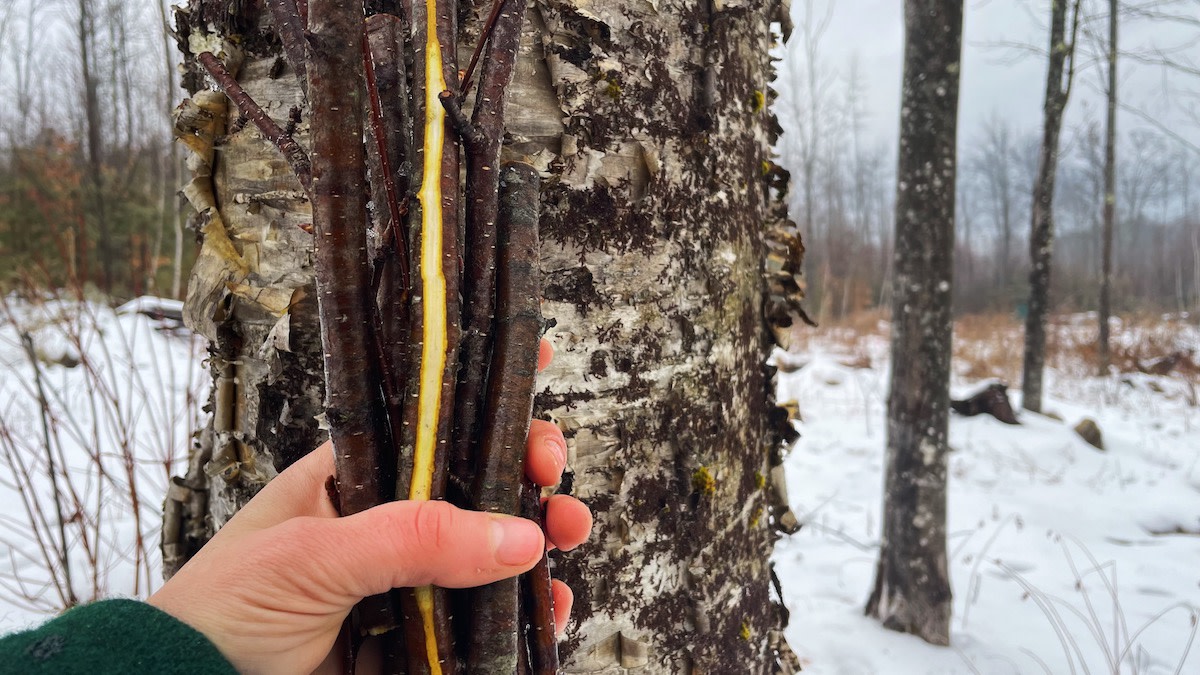
Most of my favorite childhood memories rush back to me with a whiff of mint because I likely had a birch twig clamped between my teeth when they happened. This was thanks to my best friend's older brother. He was a born-in-workboots kind of farm boy with a talent for cussing so impressively that he had only to smirk and his mom would tell him to watch his mouth—in other words, he was my kind of guy.
He drove us down to the pond for a swim, and I watched him snap the end of a birch branch, gracefully, between the fingers of one hand, shave the leaves off with his pocket knife, and put the twig between his teeth. I asked him why he did that, and he cocked his head at me like “Oh, you don’t know?” He took the twig out of his mouth, put it into mine, told me to chew, and I was hooked.
The warm, spicy, mint that flooded my mouth was so inherently pleasing to me that it was a surprise to learn, later in life, that much of the world is repulsed by it. Methyl salicylate, the compound in birch responsible for its wintergreen flavor, is actually the same compound in wintergreen itself (Gaultheria procumbens) which has a long history of medicinal use in Britain, notably in topical salves for its anti-inflammatory and pain-relieving qualities. It’s thought that this cultural association with medicine is why most British people turn their noses up at wintergreen as a flavor.
North Americans, however, have long used it in things like candy, gum, baked goods, and root beer, so we happily associate it with sweet treats, or in my case, unrequited puppy love. The active ingredient in those topical treatments is called “wintergreen oil,” a steam distillation that should never be consumed, as methyl salicylate is toxic at these concentrations in the same way that a large dose of aspirin is.
How to Identify and Harvest Birch There are more than 15 species of birch trees native to North America, and many of them have edible and medicinal uses, but the ones with the strongest wintergreen flavor are sweet birch (Betula lenta) and yellow birch (Betula alleghaniensis). Both are common throughout the eastern half of the country and up into Canada, inhabiting sunny forests, edges, and in the case of yellow birch, swamps, and wet woods.
Both species, when young, have smooth, shiny bark with horizontal lines, characteristic of all birches, called lenticels. As they mature, the sweet birch will go from glossy red/brown to matte gray with vertical cracks, while the yellow birch keeps its shine and even in old age is a striking metallic gold, just a little shaggier than its younger self. Both birches have simple, ovate, alternate, serrated, light-green leaves that go brilliant bronze before they drop in the fall.
A sweet birch can look an awful lot like a black cherry tree (Prunus serotina), especially when young, but there’s an easy way to tell them apart—scratch and sniff. If you scrape through the thin bark of a young twig with your thumbnail and have a smell, a birch will smell distinctly of wintergreen, while a cherry will smell strongly of bitter almond extract.
Ideally, I like to harvest thumb-thick branches that reach out into managed trails or fields and would be cut annually anyways, or if there’s a new logging cut that sweet birch is pioneering with a high stem density, I’ll thin out a few crowded seedlings.
How to Make Sweet Birch Tea I cherish birch tea in winter because it’s one of the only things to forage during these months when most other plants are dead or dormant. Collecting the branches pairs perfectly with hunting snowshoe hare, walking out to the ice fishing pond, or looking for Chaga mushrooms. I cut my branches down into 8- to 10-inch lengths, and peel the bark off with a buck knife into a big bowl. I collect both the bark and the peeled sticks and put them all into a half-gallon jar. The tiny twigs that are too small and flexible to peel can be chopped and added to the jar as well.
I like to have the jar at least two-thirds full of birch before I fill it with room temperature water. Methyl salicylate is very volatile and will evaporate with the steam if boiled, so cold-brew is the way to go. This also means you should only use fresh branches, as the flavor will dissipate quickly when dried. The tea will be mildly minty in no time, but for full flavor extraction, I like to let it steep overnight, or even two, where it begins to lightly ferment.
The finished tea can then be strained and heated for a warming winter treat, or in the heat of summer, I like to freeze it into ice cubes and popsicles for the ultimate minty cool relief. This method not only works with water, but is also dreamy in milk and cream as an ice cream base, in alcohol to use like vanilla extract in baked goods and cocktails, and in bubbly water with a splash of maple syrup as a busy man’s birch beer soda.





